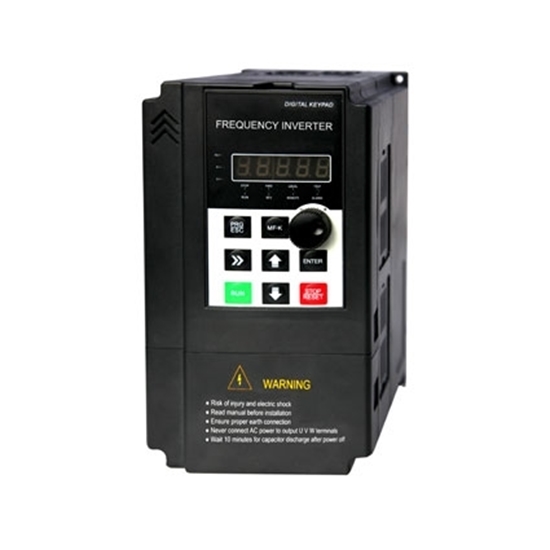
- Stock: In Stock
- Model: GK3000-SP1S1-1d5
- Weight: 1.00
- SKU: GK3000-SP1S1-1d5
Available Options
2 hp (1.5 kW) VFD, single phase 110v/120v input to single phase 220v, 230v, 240v output, single phase to three phase, 7 amps.
Specification:
| Basics | Model | EM15-SP1S1-1d5 |
| Capacity | 2 hp (1.5 kW) | |
| Shipping weight | 3 kg | |
| Dimension (W x H x D) | 120*205*166 mm | |
| I/O Feature | Rated current | 7 A |
| Input voltage | 1 phase 120V AC ±15% (Set FE-00=0) | |
| Input frequency | 50Hz/60Hz | |
| Output voltage | 1 phase or 3 phase 220V AC ±15% | |
| Output frequency | 0~320Hz (SFC) | |
| Control Feature | Control mode | V/F control; vector control |
| Communication | Offer RS485 communication interface, support MODBUS-RTU communication protocol | |
| Speed regulation | 1:100 | |
| Start torque | 150% of rating torque at 1 Hz | |
| Speed control accuracy | ≤±0.5% of rating synchronous speed | |
| Frequency precision | Digital setting: max frequency x± 0.01%; | |
| Analog setting: max frequency x± 0.2% | ||
| Frequency resolution | Analog setting: 0.1% of max frequency; | |
| Digital setting: 0.01Hz | ||
| Torque boost | Automatic torque boost, manual torque boost 0.1%~30.0% | |
| Interior PID controller | Be convenient to make closed-loop system | |
| Automatic energy save running | Optimize V/F curve automatically based on the load to realize power save running | |
| Automatic voltage regulation (AVR) | Can keep constant output voltage when power source voltage varies. | |
| Automatic current limiting | Limit running current automatically to avoid frequent over-current which will cause trip | |
| Environment | Enclosure rating | IP 20 |
| Temperature | –10℃~ +40℃; VFD will be derated if ambient temperature exceed 40℃; each rise 1℃, the derate will be 5% | |
| Humidity | smaller than 95%RH, non-condensation | |
| Altitude | ≤1000m; VFD will be derated if above 1000m | |
| Vibration | Less than 5.9 m/s2 (0.6 g) | |
| Cooling | forced air cooling | |
| Store environment | –20℃~ +60℃; no dust, no corrosive gas, no direct sunlight |
Note: RDDLZ VFD Cannot be used as a power source, it Can only be directly connected to an induction motor to control the motor speed.
Tips: Variable Frequency Drive vs Soft Starter
If you need to vary the speed of the driven load, then a VFD is definitely the choice. If you are looking to reduce the starting current and the starting torque of an induction motor, then a soft starter can be selected.
If energy savings (reduced speed) is the issue a VFD will almost always be the first choice, but again the driven load, (VT) and application require review and sizing considerations. If speed control is the consideration then a constant torque load will require a VFD. The motor basics we have had to live with, NEMA design A, B, C & D are there for a reason as one design doesn't fit all applications. The controller is just another tool to use within it's limitations to provide the desired result for an application.
Soft starter - considerably cheaper than VFDs, much more efficient, does not require harmonic mitigation, but draws 3 - 4 times start current and does not offer variable speed feature. Understanding the application and exactly what you are trying to achieve would be the most important factor.
